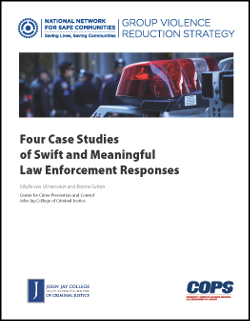
The National Network for Safe Communities’ group violence reduction strategy holds that violent crime can be dramatically reduced when law enforcement, community members, and social services providers join together to directly engage with violent street groups and gangs to clearly communicate: (1) a law enforcement message that any future violence will be met with clear, predictable, and certain consequences; (2) a moral message against violence by community representatives; and (3) a genuine offer of help for those who want it.For the strategy to achieve its desired outcomes, stakeholders must be authentic and their messages credible. For law enforcement this means making good on the promise of swift and meaningful consequences for a group or gang as a whole when a prohibited violent act (usually shooting or killing) is committed by one of its members. Group Violence Reduction Strategy: Four Case Studies of Swift and Meaningful Law Enforcement Responses captures examples of successful and creative law enforcement responses to group violence as carried out by police departments at key National Network jurisdictions.
